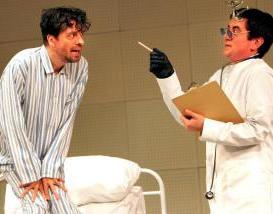SEARCH CurtainUp
REVIEWS
FEATURES
NEWS
Etcetera and
Short Term Listings
LISTINGS
Broadway
Off-Broadway
BOOKS and CDs
OTHER PLACES
Berkshires
London
LA/San Diego
DC
Philadelphia
Elsewhere
QUOTES
On TKTS
LETTERS TO EDITOR
FILM
LINKS
MISCELANEOUS
Free Updates
Masthead
NYC Weather
 London Review
London Review
Ying Tong - A Walk With The Goons
by Brian Clover
|
Tenor: There's a song that I recall
My mother sang to me.
Sprigs (off): Oh! (a sigh) Tenor: She sang it as she tucked me in When I was ninety-three. Bluebottle + Sprigs: Ying tong ying tong/Ying tong ying tong/Ying tong iddle I po |

James Clyde as Spike Milligan and Peter Temple as Peter Sellers
(Photo: Keith Pattison)
|
The BBC is one of the peculiarities of British history. For most of the last century this publicly funded monopoly entertainment broadcaster was run by a tiny coterie of Oxbridge-educated public school boys who dictated what the entire nation could laugh at. Of course this was not an accident: the British Establishment understood the subversive potential of humour. They were well aware that jokes had helped to bring about, and sustain, the Russian Revolution. (Sample gag: "Comrade, how many tsars does it take to change a light bulb?" "Comrade, your question is meaningless since light bulbs are not included in the current Five Year Plan and tsarism has been liquidated… As you will be. Ha Ha Ha!" (Extract from MI5 Dossier, with comment, "Deadly material of this nature could be launched against Britain within 45 minutes!")
The taste of this pin-striped mafia was pretty awful. But despite this, a few extraordinary comedy shows did get under the wire and none was more seditious than the Goon Show. Ying Tong - A Walk with the Goons is a fantasia on the life of its creator, Spike Milligan, a man much loved in this country, if only for insulting Prince Charles in a live TV broadcast while the heir to the throne was actually making a speech in his honour. Spike developed, wrote and starred in this surreal radio show - think the entire cast of a Marx Brothers film on LSD - from 1951 to 1960. His insight, possibly unique for a mass entertainer, was that in a psychotic world your best defence is psychosis. While the tenets of Absurdism were being solemnly declaimed to a tiny elite in art theatres, Spike was making an entire nation laugh with better material that he changed every week. (I speak as something of a fan.)
Arguably, comedians are the true artists of the troubled Twentieth Century. They certainly have a more direct relationship with the world and the audience for whom they translate its funny little ways. A novelist or playwright's decline tends to be slow and graceful: a comic's is more likely to be catastrophic. This was Spike's terror: not that he ever actually lost the love of his audience, but that he feared it would happen.
Thus the play opens with Spike in 1960 in a psychiatric hospital. He hallucinates real characters, such as fellow Goons Peter Sellers and Harry Secombe, as well as the invented ones he created for them. Can he please them, conquer his writer's block, go back and recreate the success of the Goons? Or must he pay the high price of moving on, whatever that is?
Author (the aptly-named) Roy Smiles offers one interpretation of this episode and Spike himself. Fans of the man and his show may not agree with this reading, but they will be fascinated by the presentation of it. Smiles invents and re-invents characters, and devises routines to dramatise our hero's terrors. He even has the temerity to create a good part of a Goon Show itself. One cannot doubt his courage, though perhaps not all his conceits are equally successful and at times the pace slackens.
However, James Clyde gives a powerhouse performance as Spike, not as perfect a mimicry as Christian Patterson achieves for Harry Secombe, but an awesome impression of a tortured man. Peter Temple as Peter Sellers is an excellent mover, though inevitably he is overshadowed by Geoffrey Rush's magisterial performance in the recent biopic of that equally troubled star. Jeremy Child makes you feel for announcer Wallace Greenslade, straightest of straight men, especially when humiliatingly out of his depth as a woman.
But I do wonder what a non-fan will make of this piece. Perhaps the characters need a little more, or little less, explaining than they get here. Anyone who has never heard a Goon Show may feel lost and, to be frank, some of the material, as pastiched here, sounds, well, silly after all these years. But that was part of the fun at the time and Smiles' achievement is to blend that fun with the pain that surrounded its creation.
Ying Tong is the most recent of the cycle of pieces re-working British comedy acts of the 50's and 60's. The unkind might argue that these tend towards the superficial, parochial and parasitic, however absorbing they are as performances. Smiles tries to buck this trend by opening out the action into the psyche behind the act. Whether you agree with his take or not, the attempt is worth watching.
| Ying Tong
Written by Roy Smiles Directed by Michael Kingsbury With: Jeremy Child, James Clyde, Christian Patterson and Peter Temple Designer: Peter McKintosh Lighting Designer: Tony Simpson Sound Design: Mic Pool Composer: Richard Taylor Running time: Two hours with one interval Box Office: 0870 060 6627 Booking to 4th June 2005. Reviewed by Brian Clover based on 14th January 2005 performance at the New Ambassador's Theatre, West Street, London WC2 9ND (Tube: Leicester Square) |


Mendes at the Donmar
Our Review

Peter Ackroyd's History of London: The Biography

London Sketchbook

Retold by Tina Packer of Shakespeare & Co. Click image to buy.
Our Review

6, 500 Comparative Phrases including 800 Shakespearean Metaphors by CurtainUp's editor.
Click image to buy.
Go here for details and larger image.
